BMES Outreach Exposes High School Students to Career Possibilities in Bioengineering
October 25, 2016

Two "Bioengineer Your Impact" participants are close to finishing their prosthetic hand prototype.
What is a bioengineer? What do bioengineers do? This is what 20 high school students from around the state hoped to find out at “Bioengineer Your Impact" on Saturday, October 22, 2016. Hosted by BMES, the (Biomedical Engineering Society), a student organization for Bioengineering (BIOE) undergrads, it was the organization’s first large outreach for high school students and was designed to pique the young visitors' interest in Bioengineering. During the day, highschoolers interacted with current BIOE students as student panels shared with the younger students about their experiences in research and as interns in industry. Plus, a variety of presentations and activities helped visitors discover the breadth of bioengineering career opportunities available to them in academia, industry, and the medical fields.
During the event, visitors got lots of chances to interact with Illinois BIOE students. For instance, they heard from a couple of student panels; one comprised of both grad students and undergrads discussed some BIOE research applications. Another panel of BIOE undergrads shared about their experiences as interns in industry. Plus, to further help students understand research opportunities at Illinois, visitors toured several labs in the Institute for Genomic Biology.
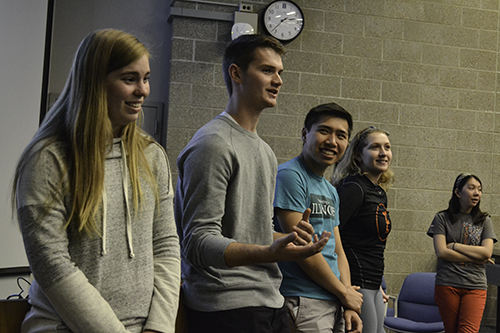
A panel of Bioengineering students share about their experiences as interns in industry.
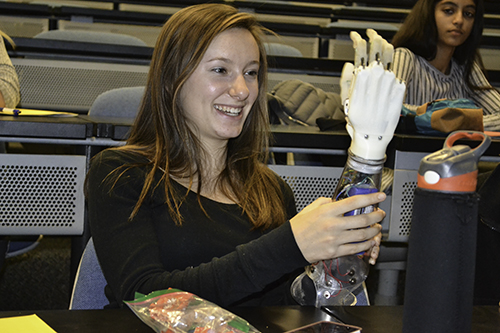
A high school participant makes the fingers of Aktar's prosthetic hand move.
BMES’ Outreach Director, Katherine Kiang, a junior in Bioengineering specializing in Cell and Tissue, reports that the interactions with Illinois students helped expose highschoolers to the many career options in BIOE: “They’re going to also meet a ton of different students who are either volunteers or speaking on the panels, and they all have such great experiences. So just by seeing that there are people that have done this vs. this, I think is going to be the biggest thing to show them just how diverse the field is.”
Speakers for the event included Assistant Professor Jenny Amos, who shared about Illinois’ new engineering-based College of Medicine at the intersection of engineering and medicine. MD/Ph.D. student Aadeel Aktar also spoke, sharing about his experiences in prosthetics, including his new startup company, Psyonic, which builds low-cost prosthetics. Aktar's prosthetic hand is ground-breaking, in that sensors allow an amputee to control the prosthetic's movement using the same muscles in his/her arm that controlled their hand; plus, the sensors transmit back to the brain the sensations of what the "fingers" are touching,
During the afternoon Design Challenge, participants teamed up to design prosthetic devices, then create prototypes using string, tape, cardboard tubes, plastic coils, etc.
Why would busy university students dedicate a Saturday to outreach targeting high schoolers? Kiang hopes to show them that BIOE is a great career option:
“They’re at the age when they’re really thinking about their career paths, so they’re able to grasp these things we’re telling them. This is kind of a higher level than just trying to get people excited about math and science or teaching them what engineering is. It’s a little more specific.”
According to the event co-chair, Jennifer Zupancic, a BIOE junior specializing in therapeutics, one goal of the outreach was to inform visitors about the breadth of careers available in Bioengineering.
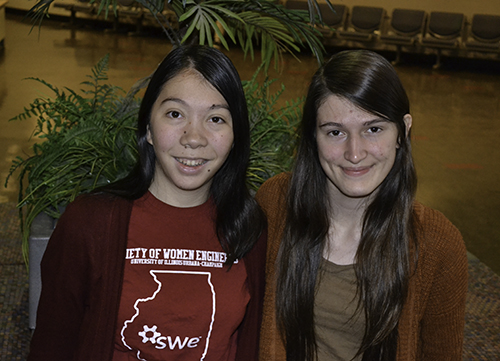
BMES Outreach Director, Katherine Kiang, and "Bioengineer Your Impact" co-chair, Jennifer Zupancic.
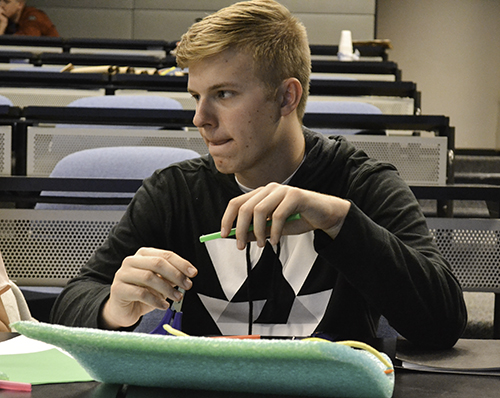
A high school student works on his team's prosthetic device during the design challenge.
“A lot of people have a design idea when they hear bioengineering, but it doesn’t usually encompass all the different fields. So they might think, ‘Oh, it’s just prosthetics,’ or ‘It’s just medical devices.’ But there can be a wide range.”
Since participants who signed up for the event were specifically considering careers in the Bioengineering field, she added that it’s important that they more fully understand what they're signing up for: “When you’re deciding what you want to major in in college, it’s good to have a full understanding when you go in, because sometimes you might get there and go, ‘Oh, I wanted to do computational. But BIOE with a CS focus was better than just CS.’”
Like Zupancic, Kiang’s goal for the event was to show students how diverse of a career path each could have as a Bioengineering student.
“A lot of times, people just think, ‘Oh, bioengineering. You’re going to go to med school,’ or ‘Bioengineering. You’re going to make prosthetics.’ There’s just so much you can do, because it’s such a diverse field, and it’s so new. So showing them that, and decreasing any misconceptions they might have as to what this bioengineering field, which is a pretty new field, can let them do.”
Another BIOE student who took part in the event was Jackie Chen, a junior specializing in Computation and Systems Biology. During the student panel about internships in industry, Chen shared that he served as an Advanced Imaging and Modeling Intern at Jump Simulation in what he claims was a very programming-and-communication-heavy internship. “Because I was developing an Android application from scratch,” he explains, “I had to communicate with various doctors to understand the best approach to implement my product.”
Chen, always interested in mentorship and outreach with K-12, is also involved in Engineering Outreach Society and Engineering Ambassadors, which work with local schools to inspire students to pursue STEM. And he got involved in "Bioengineer Your Impact" in particular to “give these highschoolers insight on what it means to be an engineer and to work with medicine. These were insights from an engineering student that I wish I had when I was in high school.”
Like Chen, other BIOE students wish they had had a similar opportunity in high school. For example, this is why Zupancic does outreach:
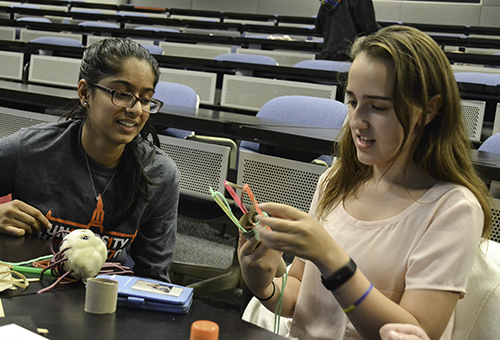
Two participants work on a hands-on activity.
In the past, I have helped with several large outreach events to educate high school students as well as younger students about engineering in general through SWE. The events provided students with an opportunity to learn more about the various engineering majors from students currently studying them, and I wish I had had a similar opportunity in high school. Due to my interest specifically in bioengineering, I think it is important for high school students to be able to learn more about the field when deciding on a major.
Katie Douglas, co-chair of the event, feels the same way: “I wanted to help with this event because a lot of high schoolers don't know what bioengineering is. It would have been helpful to have an event like this when I was trying to decide on a major for college.”

Shannon Tripp discuss the materials she and her teammates should use to create a prosthetic hand during the afternoon design challenge.
And this was exactly why Shannon Tripp, a sophomore at Carl Sandburg High School in Orland Park, a Chicago suburb, participated in “Bioengineering Your Impact.” She is specifically exploring careers in Bioengineering and wanted to find out more about it.
“Last year in biology, we learned about bioengineering, and I thought it was supercool!” she acknowledges.
Tripp also particularly enjoyed Aktar's prosthetic hand presentation: "Yea, I thought that was phenomenal. It was amazing."
Tripp says she found the event helpful in finding out more about a career in bioengineering. "It gave me a lot of insight into what you can do with a bioengineering degree, and how you can use it in different ways.”
Another participant, Bianca Rubel, an eighth grader at University Laboratory High School in Urbana, came to the event because she enjoys events about engineering and science. "I love going to all of these engineering events. I've gone to a ton, and I always have a lot of fun." Does she intend to go into engineering? "I don't know, honestly," she reports. "I have no idea what I'm going to do, but engineering's definitely a possibility."
For additional I-STEM web articles related to Biomedical Engineering and Bioengineering, see:
- Bioengineering Undergrads Build Biobots in New BIOE 306 Course
- Two Illinois Students to Make Low-Cost Bionic Prosthetics More Accessible
- BIOE Students Shine in Senior Design
Story and photos by Elizabeth Innes, Communications Specialist, I-STEM Education Initiative
More: 8-12 Outreach, BioE, 2016
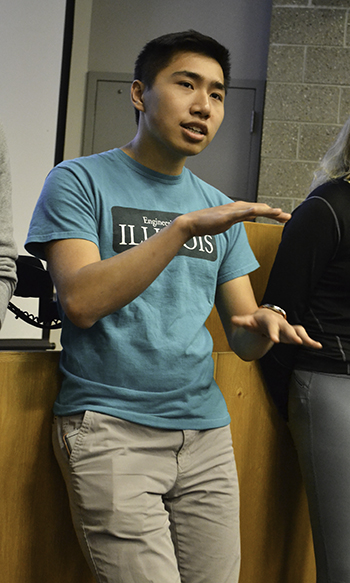
BIOE junior Jackie Chen shares with the high school students during the student panel on internships in industry.
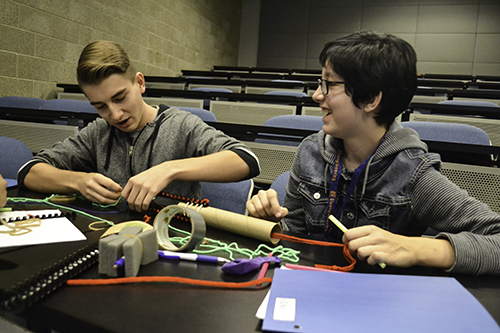
Bianca Rubel (right), and a teammate create a prosthetic hand during the afternoon's design challenge.
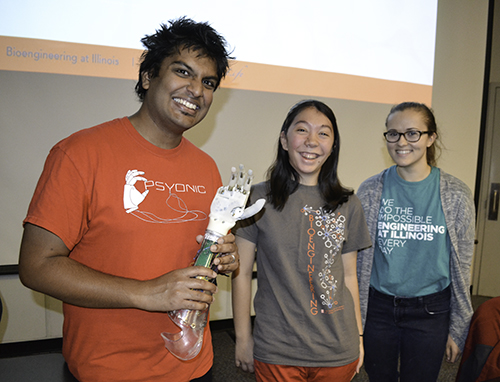
Left to right: Aadeel Aktar exhibiting the prosthetic hand he's designed, Katherine Kiang, BMES’ Outreach Director, and Katie Douglas, Event Co-Chair

A high schooler has some fun during the design challenge.
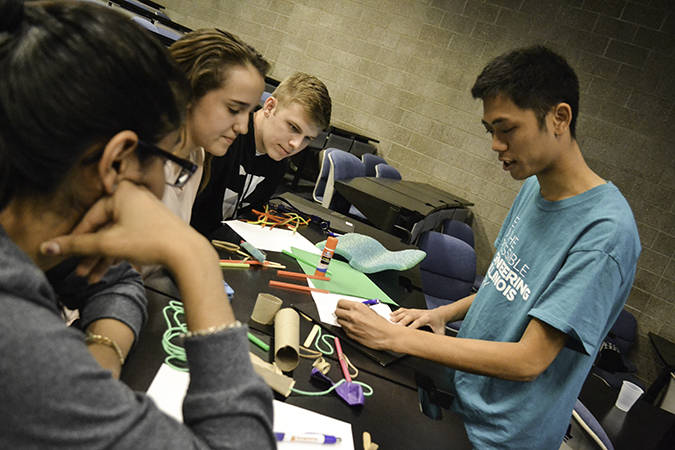
BIOE student Michael Qian (right) works with a team of high school students creating their design project.













.jpg)
















